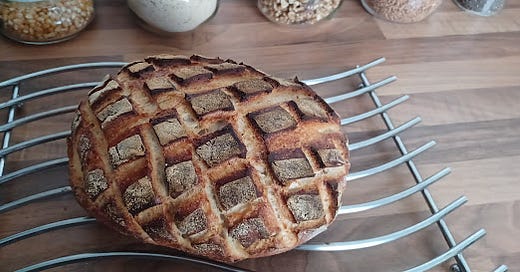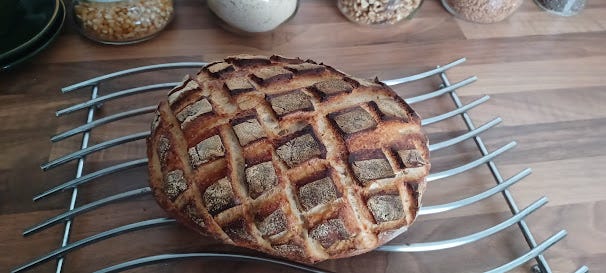Since Christmas we’ve been baking pretty regularly with our own sourdough starter. We were given one by a friend of my wife’s in November, but managed to kill it pretty quickly. Our own has slowly colonised its own jar - at one point spreading into three jars as my wife is loathe to throw any of it away.
We’ve now got quite a good cycle for feeding, making a sponge, making a dough and baking with it. It’s great bread and has the added advantage of being non-boating unlike the usual steam-blast-baked bread on British shelves. We see similar loaves going for £4-6 on a farmer’s market.
The main adjustment has actually been in planning. If we want bread for Sunday breakfast it requires some forethought. It doesn’t actually take much active time, but the steps need to be taken on the right days.
For the Sunday breakfast bread, we’d have to be feeding the starter on Thursday to ensure it’s good and active.
Friday is sponge day, when we make a sponge with a ladle of sourdough, warm water and about half the flour we’ll end up using. This sits in a stainless steel bowl proudly wearing a flowery shower cap.
The next morning, Saturday, is dough time. I typically make up the dough in our mixer (adding salt and a good glug of olive oil). It certainly does need further kneading by hand though. The dough then sits in a shower-cap covered bowl in our sunniest window until we get back home from whatever Saturday market or activity we have planned.
Later on in the afternoon, we’ll knock the dough back and knead it again. At this time our oven goes on full blast and the cast iron Dutch oven goes in. About 30 minutes later, we put the dough from baneton to hot Dutch oven. We’ve found 30 minutes with the lid on, and 15 minutes after uncovered, works best for us.
Each loaf takes about 30 minutes active work, 72 hours growing an rising, and a starter which is five and a half months old. Sourdough mindset is different, and trying to shave any of these times or processes just doesn’t work.



